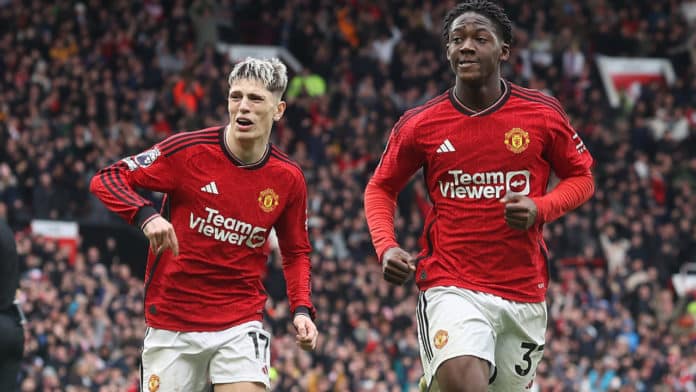Stats are very deceptive. What they show you is interesting, but what they hide is vital. Manchester United’s clash against Liverpool was the perfect embodiment of this quote. The game’s scoreline of 2-2 gives us an impression that this was a close game. However, Liverpool could have easily decimated United had it not been for some poor finishing combined with gutsy defending from the home side.
After falling behind to an early Luiz Diaz goal, United must have counted themselves lucky to go into the second half only a goal down. However, this meant that they always had a chance to get back into the game. And they did get that moment in the 50th minute of the game. Jarell Quansah misplaced a pass straight to Bruno Fernandes, who saw that Caoimhin Kelleher was off the line to conjure up a brilliant shot from almost 45 yards to equalise. This was also United’s first shot in the game.
The goal was the inspiration Ten Hag’s men needed as they came out all guns blazing. And they would soon find themselves in the lead. Kobbie Mainoo got the ball on the edge of the box before turning and unleashing a beautiful curler into the top right corner.
Despite being outplayed for the majority of the game, the hosts found themselves in the lead. With the game slipping away, Klopp responded by sending in Copdy Gakpo and Harvey Elliott as substitutes. And it was the latter whose quick feet drew a reckless challenge from Aaron Wan-Bissaka inside the box; Mohammed Salah stepped up and duly converted the penalty.
Manchester United vs Liverpool stats
Manchester United started the game in fine fashion, keeping up the pressure on the visitors. However, what eluded them throughout the first half was their passing in the final third. They did not have a single shot in the first half, which means their Expected Goals (xG) was zero, while Liverpool’s had already raced to 1.59 in the same period.
On the other hand, Liverpool had 15 shots in the first half, four of which were on target. They could have built an almost unassailable lead if they had been more clinical.
In the first half, United’s best play seemed to be their defenders, who made several last-ditch tackles. Jurgen Klopp’s men duly exploited the midfield’s lack of cohesion. The triumvirate of Wataru Endo, Dominik Szoboszlai, and Alexis MacAllister won the second ball. In addition, MacAllister and Szoboszlai bypassed the opposition often in the first half.
Kobbie Mainoo vs. Liverpool:
✅100% tackle win rate
🛡️8/9 duels won
⚔️5/5 tackles won
⚡️2/3 dribbles completed
❌2 blocks
⚽️1 goalTop performance from the 18 year old💪🏾⭐️ pic.twitter.com/p2ZWJhTL4G
— FIVE (@FIVEUK) April 7, 2024
Andy Robertson, who returned after a spell on the sidelines, was at his imperious best. In the first half alone, the left-back created three chances. He formed a devastating partnership with Luis Diaz, who scored the first goal of the game. Apart from that, the Colombian was a menace to the opposition’s defence.
Liverpool fullbacks continuously got massive space on the flanks. This allowed them to put the ball into the box, which means United spent most of their time in their half.
Despite United’s comeback, Liverpool had the better chances in the second half. According to the xG metric, the Reds were expected to score two goals. On the other hand, their opponent ended the game with an xG rating of only 0.71.
Manchester United vs Liverpool Stats Comparison |
||
| Metrics | Manchester United | Liverpool |
| Possession | 38 | 62 |
| Passes | 274 | 480 |
| Touches in Opposiiton’s Box | 16 | 59 |
| Shots | 9 | 28 |
| Shots on Target | 5 | 7 |
| Expected Goals | 0.71 | 3.59 |
| Expected Points | 0.08 | 2.87 |
| Field Tilt | 27 | 73 |
One of the main differences in the second half was the relentless off-the-ball work that United put in running 110 kilometres. Bruno Fernandes was the best player for the hosts, ending the game with one goal, one key pass, and five clearances.
After this game, Liverpool find themselves second in the Premier League table on goal difference. United, however, now find themselves 11 points adrift of fourth-placed Aston Villa.

